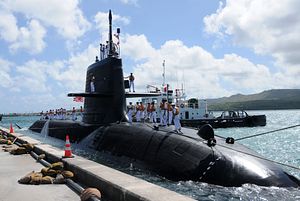The Cabinet of Australia’s National Security Committee has purportedly ruled out Japan’s bid for a $50 billion ($38.8 billion) contract–Australia’s largest defense deal ever–to build the country’s new submarine fleet in partnership with Australian industry, according to the Australian Broadcasting Corporation (ABC).
“While it is not clear if the committee has made a final decision, it has all but eliminated the Japanese bid to build a fleet of 12 submarines to replace the Royal Australian Navy’s ageing Collins Class subs,” ABC revealed this Wednesday. Japan is offering a variant of its 4,000-ton Soryu-class diesel-electric attack stealth submarine fitted with a new lithium-ion battery propulsion system.
Australian defense officials have voiced their concerns over a Japanese offer that initially emerged as an “understanding struck between [former Australia Prime Minister Tony] Abbott and Japanese Prime Minister Shinzo Abe,” the report continued.
Among other things, the Australian Defense Department appears concerned that any deal signed with Japan could be negated by the powerful Japanese bureaucracy, which allegedly showed “less enthusiasm (…) for the deal and that would undo it in the long run.”
Quiet U.S. pressure to opt for the Japanese submarines–U.S. officials allegedly indicated that the United States would not allow its most advanced weapons systems to be installed on European-made subs–has also apparently been dropped. U.S. President Barack Obama made it clear to Prime Minister Malcolm Turnbull that the submarine deal was a sovereign issue of Australia and that the selection of France or Germany would not in any way affect the Australia-U.S. alliance.
The news that Japan has apparently lost the bid comes a day after Mitsubishi Heavy Industries (MHI), one of two Japanese shipmakers building Soryu-class subs–the second Japanese defense contractor building the boats is Kawasaki Shipbuilding Corporation–established a fully owned subsidiary in Sydney.
The subsidiary was setup to “to strengthen ties with Australia’s governmental institutions and economic and industrial sectors” and “to serve as a base for developing relationships with Australia’s academic bodies, including universities and research institutes,” according to an April 19 report by The Japan Times that quotes an MHI press release.
It is also worthwhile noting that in November 2014, Australia’s Senate Economics Legislation References Committee rejected the Soryu-class as an option.
As I reported previously:
In February 2015, the Australian government asked Germany, France, and Japan to bid for the country’s largest defense procurement program (the so-called SEA-1000 acquisition project)—a contract to build up to 12 new submarines for the Australian Royal Navy, replacing the six Collins-class submarines currently in service.
The requirements outlined in the bid including a 4,000-ton displacement, a range and endurance similar to theCollins-class submarines, sensor performance and stealth abilities better than the Collins, and a combat system and heavyweight torpedo developed jointly by the U.S. and Australia as the preferred combat system and armament, makes an off-the-shelf solution not an option.
As I outlined before, the Australian submariner community has remained skeptical of the Soryu-class boats:
Among other things, they point out that on average Japanese subs are constructed to last for around 19 years, whereas the Australian governments expects at least a 30-year active service life span. The Japanese boats also have much less accommodation space than Collins-class submarines.
Additionally, the much talked about air-independent propulsion (AIP) system is actually Swedish technology. However, the Australian government has so far not shown any interest in AIP, preferring a lithium-ion battery option, which will be built into the next batch of Soryu-class subs. Nevertheless, advanced lithium-ion batteries are one of Japan’s top military secrets and it seems unlikely that Tokyo has agreed to share this sensitive technology with Canberra despite media reports.
There is also a safety concern over the use of advanced lithium-ion batteries as a former submarine engineer recently pointed out: “In the life of 100,000 [lithium-ion] cells and a fleet of 12 submarines there is likely to be a failure that cannot be stopped or controlled, with a catastrophic outcome. The Boeing 787 battery fires and the burning of the US Navy’s Advanced Seal Delivery System are reminders that contemporary lithium-ion is not yet safe enough for submarines.”
In addition, I explained:
The Japanese subs also allegedly have less range than the current Collins-class submarines in service. Furthermore, another concern is the integration of a U.S. combat system and weapons ( Mk 48 Mod 7 CBASS heavyweight torpedoes) into the Japanese hull.
However, Japan recently issued a report claiming that concerns over the submarine’s limited cruising range were unfounded.
Overall, the ABC report cannot be verified independently and has to be taken with a grain of salt. As I reported in January 2016 (See: “Has Germany Lost the Bid to Build Australia’s New Submarines?”),Germany allegedly also has already lost the bid over technical concerns, according to information supplied by an anonymous industry source. Yet the recent ABC report makes it clear that Germany continues to be one of the three contenders.
































